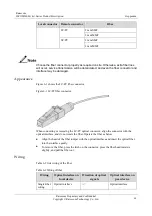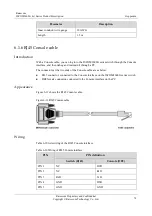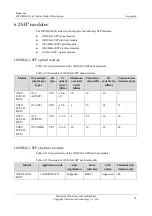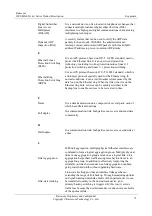
Raisecom
ISCOM2600G (A) Series Product Description
6 Appendix
Raisecom Proprietary and Confidential
Copyright © Raisecom Technology Co., Ltd.
79
Digital Subscriber
Line Access
Multiplexer
(DSLAM)
It is a network device, often located in telephone exchanges, that
connects multiple customer digital subscriber line (DSL)
interfaces to a high-speed digital communications channel using
multiplexing techniques.
Dynamic ARP
Inspection (DAI)
A security feature that can be used to verify the ARP data
packets in the network. With DAI, the administrator can
intercept, record, and discard ARP packets with invalid MAC
address/IP address to prevent common ARP attacks.
E
Ethernet Linear
Protection Switching
(ELPS)
It is an APS protocol, based on ITU-T G.8031 standard, used to
protect the Ethernet link. It is an end-to-end protection
technology, including two line protection modes: linear 1:1
protection switching and linear 1+1 protection switching.
Ethernet Ring
Protection Switching
(ERPS)
It is an APS protocol based on ITU-T G.8032 standard, which is
a link-layer protocol specially used for the Ethernet ring. In
normal conditions, it can avoid broadcast storm caused by the
data loop on the Ethernet ring. When the link or device on the
Ethernet ring fails, services can be quickly switched to the
backup line to enable services to be recovered in time.
F
Frame
It is a data transmission unit, composed of several parts, each of
which has different functions.
Full duplex
In a communication link, both parties can receive and send data
concurrently.
H
Half duplex
In a communication link, both parties can receive or send data at
a time.
L
Link Aggregation
With link aggregation, multiple physical Ethernet interfaces are
combined to form a logical aggregation group. Multiple physical
links in one aggregation group are taken as a logical link. Link
aggregation helps share traffic among member interfaces in an
aggregation group. In addition to effectively improving the
reliability on links between devices, link aggregation can help
gain greater bandwidth without upgrading hardware.
Link-state tracking
Link-state tracking provides an interface linkage scheme,
extending the range of link backup. Through monitoring uplinks
and synchronizing downlinks, faults of the upstream device can
be transferred quickly to the downstream device, and
primary/backup switching is triggered. In this way, it avoids
traffic loss because the downstream device does not sense faults
of the upstream link.






































